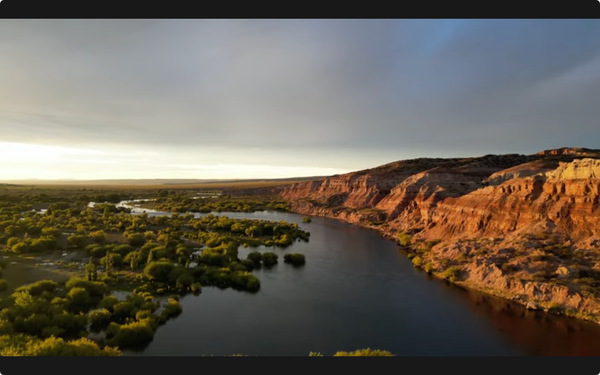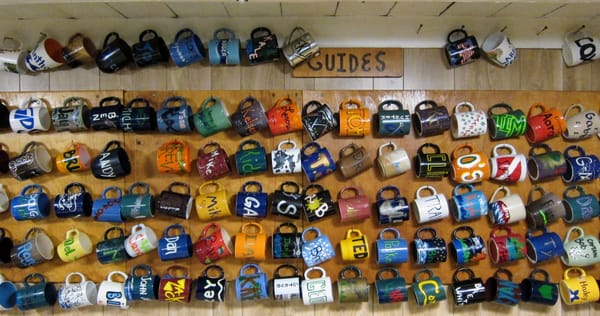Tap into the Wisdom of the Guides
Gleaning advice for taking your first guided fly-fishing trip from legendary fly-fishing guides and a tome that's stood the test of time

One major rite of passage in fly-fishing is going on your first guide trip. It's a big milestone in a beginner's path to becoming an angler.
For one, a trip with a fly-fishing guide is a commitment. You have to spend a significant chunk of time fishing. And you have to pay someone—a hefty sum—to do so.
Fly-fishing with a guide can be painful. It exposes your own weaknesses and shortcomings. At some point in the day, someone will be cringing.
It might be the guide who cringes. They're doing everything they can to put their client on fish. But the client is oblivious, and keeps making mistakes.
At some point, the guide reclines and resigns. Pops in another handful of dill pickle-flavor sunflower seeds. Limits their feedback to calling out "Mend!" and "Set!" as the customer watches their indicator. Nothing will be learned that day.
It might be the ultra-self-aware, bashful angler who cringes. They know their cast isn't the greatest yet. They fumble with the rod, and gets the line tangled. It's scary and hard for them to put their own poor technique on display.
Here's the good news: If you're reading this, you're likely on the second path. I'm here to tell you it's OK. The tentative openness of a beginner, the soft and tender sponge mode necessary to acquire new skills, is the mode that guides like best.
Wisdom of the Guides, by Paul Arnold, published in 1999 by Frank Amato Publications, asks ten fly-fishing guides from the Mountain West the same general series of questions. Each shares their broad philosophy, and their tricks of the trade. It's a treasure trove of tips from people who have made a livelihood from fly-fishing.
Some, like fly-tiers Al Troth and Gary LaFontaine, spend more time talking fly-tying and patterns. It makes sense. LaFontaine is a legendary fly innovator. Al Troth invented the Elk Hair Caddis. Some interviewees spend more time talking conservation, like Craig Mathews, of Blue Ribbon Flies, a co-founder of 1% For the Planet.
But all the legendary fly-fishing guides touch on what makes a great client.
It's not the guy who comes in saying "I'm an expert at home, I want to catch a 36" brown today." Great clients are the anglers who come in with an attitude of learning and study. They want to understand the area, or pick up a new technique.
You might be an absolute beginner who just declared yourself Mayor of Tangle Town. Or, you're an accomplished angler who's seen a thing or two. Either way, a growth mindset is what's going to make your time with a guide most valuable.
Here are some tips, and bits of reassurance for anyone taking their first guided fly-fishing trip. The Wisdom of the Guides has an awful lot more, but "advice for clients" is plentiful throughout.
Here are five tips, and four tidbits to take with you, to make your first time fly-fishing with a guide a success:
Listen to the guide
Taking your first guided fly-fishing trip might be your first exposure to an angler who has their whole setup dialed. A good guide is on the water every day during the season. They'll float on their days off, too, scouting and fishing with their friends. They know the rivers and lakes they fish.
Guides live and breathe the logistics that make a trip hum. They have the broad planning in hand, and know the gear, the fishing program. Everything to let the client (or "custie", or "dude," take your pick) focus on the fishing.
When the author asks "What's your favorite kind of client to take fishing," guides always answer "Someone who will listen."
So, the number one rule is to listen up. The guide has been doing it a lot longer than you have.
Ask the guide questions
Second to listening is to ask questions.
- Why do you do it like this?
- What's the rationale behind this way of fishing?
- What bird is that?
- When do you see your family? (Kidding, don't ask that.)
"You can ask me questions all day and that makes me feel really good. I want to know what you want to know, so I can see if I know it," said Jennifer Olsson of Bozeman, Montana. "I love teaching and I love taking that fear away, if I can do that. You might say I'm possessed by wanting to help people, wanting to have them enjoy what I teach them."
Every guide is different, and all will have answers, even if some of them are smart-ass answers. But, you won't know the answers if you don't ask the questions.
Here's more from Jennifer Olsson, from the lost PBS gem, the Western Fly Fishing Journal.
Keep your eyes open
A good fly-fishing guide must be an expert noticer.
For example: here's what the guide sees on a float trip in a drift boat. The guide has to watch the river, to row the boat safely, and position their anglers' flies. They have to watch the anglers, front and back, to see where their casts are going, to bring them into casting distance to fish. And they have to watch the river, to see bugs and rising fish and all the other signs that might point to where fish are.
A guide will be taking in dozens of visual stimuli each second, and responding in turn. You can help them by staying alert and focusing on observation. "Rule number one for catching more fish is to stop and look," says LaFontaine.
You can help the guide by being a second set of eyes. Share what you're seeing, and call it out. Start with rising fish. Once you and the guide sync up on rising fish, and the guide knows you know, things will be much smoother. You'll develop a communication pattern you both can rely on, so "short cast, ten feet, 10 o'clock, off that inside seam," carries more meaning.
When you're back fishing on your own, you want to follow a similar approach. "I think you should start fishing 10 feet before you even get to the bank," said Larry Tullis, who guided Utah's Green River many years. "Start looking at the vegetation to see if there are some bugs that have been hatching that are underneath shady leave and under logs. Then pick up a few rocks close to share and see what nymphs are available. Or even better get an insect screen out and get a sampling to know what aquatic insects are there in the moment."
Fish out every cast, everywhere
Face it: as a beginner, your casts are going to be ugly. But the guides in the book tend to believe that even ugly casts catch fish. So it's important to let even the ugly casts fly fish, if you've got a good drag-free drift.
"I'll have clients cast into the seam and let the current bring it into the still water. And the tendency for a lot of people is to pick it up and cast it again right away, the moment the indicator stops moving." said Johnny Gomez, who guided the San Juan for many years out of Abe's Fly Shop. But that's the wrong way to go. Big fish hang out in slow water, which means it's critical to let those drifts fish.
Similarly, anglers want to remember that fish hang out near the banks. Casting at targets near the bank means you can cover that initial 5-10' where fish may gather. "A lot of guys, when they're wade fishing, walk right up to the bank and start casting out, but the best thing to do is start fishing along the bank and work your way out," said Gomez.
"Fish feed in very, very shallow water," said LaFontaine. "They feed at the lips of pools, they feed on the little gravel shelf coming in on the shallow side and they snub up right close to the bank. And when people step into the water and spook fish, they've spooked not only those fish but wherever those fish are running to."
Letting every cast fish out also means you aren't potentially ripping the fly off the water. If you're creating the tell-tale spray of water droplets, know it can put fish down.
Try and fish closer
Beginners false cast too much. Guides will advise: Knock it off. You can't catch a fish with your line in the air. Anything that takes away from your fly on the water, drifting, wastes effort.
"If they're floating [in a drift boat], they're not really covering the water. If they're wade-fishing, the unnecessary false casting, flashing the line over the fish, increases the chance of spooking those fish," says Mike Lawson, from Henry's Fork Anglers. "I think most fisherman don't get as close to the fish as they should...In order to get within 20 feet of a trout you've got to be able to do it without spooking him. "
Casting closer and more accurate is better than further and sloppier. Longer casts are also less sensitive, and harder to set the hook on, says Tom Knopick of Duranglers Fly Shop. "You get a guy who's trying to dump out 40 or 45 feet of line, then he loses control of his line and he's going to catch fewer fish. While if he'd shorten up, or wade out a little bit farther or reposition and fish 20 or 25 feet of line he'd probably catch more fish."
Tidbits to take with you
Wisdom of the Guides is a solid little book, and though it's over 25 years old most of the advice is still relevant today. Here are a few more tidbits to take with you:
- First day, not last day: Book a guide for your first few days fishing in a place, not the last few. "People will fish for five or six days without success, then take a guided trip," said Gomez. "But they've lost some good fishing by waiting."
- Adjust your position: Before you re-rig and change flies or tippet or leader, try and re-position yourself. "A lot of time just moving yourself a few feet lets you get an easy drag-free drift," said Lawson. "Maybe it's going to take more than a few feet. Maybe if you're fishing across and can't get a good drift you'll have to back out and get straight below the fish...you've got to have the willingness to move around."
- Bring the fish in quickly: Don't be afraid to put the lumber to the fish. It's healthiest for them to be caught and released as quickly as possible. "I teach people to snub 'em and bring 'em in," said Mathews. "I've gotten into discussions with people on stream where they're fighting a 16-inch fish for 10 minutes...I tell 'em to give the fish a jump and a run and just bring him on in, because you're going to kill that fish if you don't get him in and get that hook out of him."
What have you learned from a guide?
Share it in the comments!
𓆟 𓆝 𓆟




